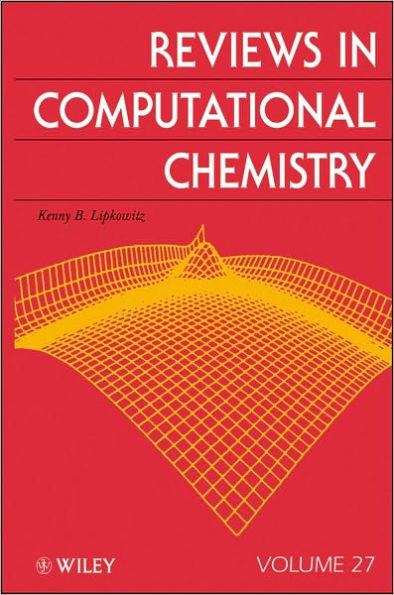Reviews in Computational Chemistry, Volume 27 / Edition 2 available in Hardcover

Reviews in Computational Chemistry, Volume 27 / Edition 2
- ISBN-10:
- 0470587148
- ISBN-13:
- 9780470587140
- Pub. Date:
- 11/30/2010
- Publisher:
- Wiley

Reviews in Computational Chemistry, Volume 27 / Edition 2
Hardcover
Buy New
$263.95Overview
FROM REVIEWS OF THE SERIES
"Reviews in Computational Chemistry remains the most valuable reference to methods and techniques in computational chemistry."—JOURNAL OF MOLECULAR GRAPHICS AND MODELLING
"One cannot generally do better than to try to find an appropriate article in the highly successful Reviews in Computational Chemistry. The basic philosophy of the editors seems to be to help the authors produce chapters that are complete, accurate, clear, and accessible to experimentalists (in particular) and other nonspecialists (in general)."—JOURNAL OF THE AMERICAN CHEMICAL SOCIETY

Product Details
| ISBN-13: | 9780470587140 |
|---|---|
| Publisher: | Wiley |
| Publication date: | 11/30/2010 |
| Series: | Reviews in Computational Chemistry , #52 |
| Edition description: | 2nd Volume 27 ed. |
| Pages: | 482 |
| Product dimensions: | 6.40(w) x 9.40(h) x 1.50(d) |
About the Author
Read an Excerpt
Table of Contents
1. Brittle Fracture: From Elasticity Theory to Atomistic Simulations (Stefano Giordano, Alessandro Mattoni, and Luciano Colombo).Introduction.
Essential Continuum Elasticity Theory.
Conceptual Layout.
The Concept of Strain.
The Concept of Stress.
The Formal Structure of Elasticity Theory.
Constitutive Equations.
The Isotropic and Homogeneous Elastic Body.
Governing Equations of Elasticity and Border Conditions.
Elastic Energy.
Microscopic Theory of Elasticity.
Conceptual Layout.
Triangular Lattice with Central Forces Only.
Triangular Lattice with Two-Body and Three-Body Interactions.
Interatomic Potentials for Solid Mechanics.
Atomic-Scale Stress.
Linear Elastic Fracture Mechanics.
Conceptual Layout.
Stress Concentration.
The Griffith Energy Criterion.
Opening Modes and Stress Intensity Factors.
Some Three-Dimensional Configurations.
Elastic Behavior of Multi Fractured Solids.
Atomistic View of Fracture.
Atomistic Investigations on Brittle Fracture.
Conceptual Layout.
Griffith Criterion for Failure.
Failure in Complex Systems.
Stress Shielding at Crack-Tip.
Acknowledgments.
Appendix: Notation.
References.
2. Dissipative Particle Dynamics (Igor V. Pivkin, Bruce Caswell, and George Em Karniadakis).
Introduction.
Fundamentals of DPD.
Mathematical Formulation.
Units in DPD.
Thermostat and Schmidt Number.
Integration Algorithms.
Boundary Conditions.
Extensions of DPD.
DPD with Energy Conservation.
Fluid Particle Model.
DPD for Two-Phase Flows.
Other Extensions.
Applications.
Polymer Solutions and Melts.
Binary Mixtures.
Amphiphilic Systems.
Red Cells in Microcirculation.
Summary.
References.
3. Trajectory-Based Rare Event Simulations (Peter G. Bolhuis and Christoph Dellago).
Introduction.
Simulation of Rare Events.
Rare Event Kinetics from Transition State Theory.
The Reaction Coordinate Problem.
Accelerating Dynamics.
Trajectory-Based Methods.
Outline of the Chapter.
Transition State Theory.
Statistical Mechanical Definitions.
Rate Constants.
Rate Constants from Transition State Theory.
Variational TST.
The Harmonic Approximation.
Reactive Flux Methods.
The Bennett–Chandler Procedure.
The Effective Positive Flux.
The Ruiz–Montero–Frenkel–Brey Method.
Transition Path Sampling.
Path Probability.
Order Parameters.
Sampling the Path Ensemble.
Shooting Move.
Sampling Efficiency.
Biasing the Shooting Point.
Aimless Shooting.
Stochastic Dynamics Shooting Move.
Shifting Move.
Flexible Time Shooting.
Which Shooting Algorithm to Choose?
The Initial Pathway.
The Complete Path Sampling Algorithm.
Enhancement of Sampling by Parallel Tempering.
Multiple-State TPS.
Transition Path Sampling Applications.
Computing Rates with Path Sampling.
The Correlation Function Approach.
Transition Interface Sampling.
Partial Path Sampling.
Replica Exchange TIS or Path Swapping.
Forward Flux Sampling.
Milestoning.
Discrete Path Sampling.
Minimizing the Action.
Nudged Elastic Band.
Action-Based Sampling.
Transition Path Theory and the String Method.
Identifying the Mechanism from the Path Ensemble.
Reaction Coordinate and Committor.
Transition State Ensemble and Committor Distributions.
Genetic Neural Networks.
Maximum Likelihood Estimation.
Conclusions and outlook.
Acknowledgments.
References.
4. Understanding Metal/Metal Electrical Contact Conductance from the Atomic to Continuum Scales (Douglas L. Irving).
Introduction.
Factors That Influence Contact Resistance.
Surface Roughness.
Local Heating.
Intermixing and Interfacial Contamination.
Dimensions of Contacting Asperities.
Computational Considerations.
Atomistic Methods.
Calculating Conductance of Nanoscale Asperities.
Hybrid Multiscale Methods.
Characterization of Defected Atoms.
Selected Case Studies.
Conduction Through Metallic Nanowires.
Multiscale Methods Applied to Metal/Metal Contacts.
Concluding Remarks.
Acknowledgments.
References.
5. Molecular Detailed Simulations of Lipid Bilayers (Max L. Berkowitz and James T. Kindt).
Introduction.
Membrane Simulation Methodology.
Force Fields.
Choice of the Ensemble.
Verification of the Force Field.
Monte Carlo Simulation of Lipid Bilayers.
Detailed Simulations of Bilayers Containing Lipid Mixtures.
Conclusions.
References.
6. Semiclassical Bohmian Dynamics (Sophya Garashchuk, Vitaly Rassolov, and Oleg Prezhdo).
Introduction.
The Formalism and Its Features.
The Trajectory Formulation.
Features of the Bohmian Formulation.
The Classical Limit of the Schrödinger Equation and the Semiclassical Regime of Bohmian Trajectories.
Using Quantum Trajectories in Dynamics of Chemical Systems.
Bohmian Quantum-Classical Dynamics.
Mean-Field Ehrenfest Quantum-Classical Dynamics.
Quantum-Classical Coupling via Bohmian Particles.
Numerical Illustration of the Bohmian Quantum-Classical Dynamics.
Properties of the Bohmian Quantum-Classical Dynamics.
Hybrid Bohmian Quantum-Classical Phase–Space Dynamics.
The Independent Trajectory Methods.
The Derivative Propagation Method.
The Bohmian Trajectory Stability Approach. Calculation of Energy Eigenvalues by Imaginary Time Propagation.
Bohmian Mechanics with Complex Action.
Dynamics with the Globally Approximated Quantum Potential (AQP).
Global Energy-Conserving Approximation of the Nonclassical Momentum.
Approximation on Subspaces or Spatial Domains.
Nonadiabatic Dynamics.
Toward Reactive Dynamics in Condensed Phase.
Stabilization of Dynamics by Balancing Approximation Errors.
Bound Dynamics with Tunneling.
Conclusions.
Acknowledgments.
Appendix A: Conservation of Density within a Volume Element.
Appendix B: Quantum Trajectories in Arbitrary Coordinates.
Appendix C: Optimal Parameters of the Linearized Momentum on Spatial Domains in Many Dimensions.
References.
7. Prospects for Career Opportunities in Computational Chemistry (Donald B. Boyd).
Introduction and Overview.
Methodology and Results.
Proficiencies in Demand.
Analysis.
An Aside: Economics 101.
Prognosis.
Acknowledgments.
References.
Appendix: List of Computational Molecular Scientists.
Subject Index.
What People are Saying About This
“The editors have done an excellent job and the book is a must on every book shelf of computational chemistry literature.” (ChemPhysChem, 2005; Vol. 6; 7)
"…this volume continues the traditions and standards of this series as a prime resource for anyone with an interest in theoretical and computational chemistry…a welcome addition to any library collection." (Journal of the American Chemical Society, March 9, 2005)
